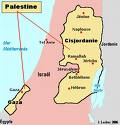Israel’s Carnage and Wreckage of Gaza: Crimes, Victims and Witnesses
Review of "Crimes, Victims and Witnesses - Apartheid in Palestine" by Mats Svensson.

Amongst all the news of the carnage and wreckage in Gaza created by the latest Israeli onslaught, Crimes, Victims and Witnesses is a sadly reflective book. Mats Svensson has combined stunning and compelling photography with short, quick, sad and often cryptic anecdotes about his experiences as a Swedish UN diplomat in Israel/Palestine.
The theme is obvious, that of apartheid, and its main barrier is the wall being built by Israel that is slowly twisting and turning through Palestinian land, separating families from families, farmers from their land, capturing the water, the fertile ground, the protected hilltops – separating the people from their freedom and hopes to carry out a normal life. The other main barrier of course is Gaza itself, the enforced isolation of a small portion of Palestinian land, completely under Israeli control and effectively separated from the West Bank both politically and geographically.
In the forward, Dr. Essop G. Pahad writes,
When South Africans visit Palestine most are shocked at how much worse apartheid is there than that of the old South Africa. And they comment that it cannot be called anything other than apartheid.
At the end of the work Svensson writes,
Apartheid in South Africa had three starting points. The first was to divide the population into groups based on race, giving the white race preference in terms of rights, services and privileges. The second starting point was the division of the country into geographically segregated areas and transferring population into these based on race. In addition, a person from one area could not access another area. The third prerequisite was a combination of security laws and rules created to oppress and suppress any resistance, which also strengthened a system of domination based on race.
The authors of the report [UN special rapporteur Prof. John Dugard] consider that the Palestinian people live under a similar system.
In between these basic points, the reality is emphasized with the stories of the everyday people of Palestine. Of wanting to see a red and white bird one last time, of walking through sewage tunnels not wanting to be photographed – to save one’s dignity. Knowing the loss of freedom to have a house, a garden, freshwater, olive trees. The children suffering, not understanding but learning, watching, families being blocked from their dreams by the wall – small dreams – to see the ocean, a bird, a family member, a sunset over a hill.
A smaller theme enters the work from the author’s own line of work as a diplomat. “Imagine all this knowledge. Knowledge that is only a click away. And just think about all this silence while the Westbank burns.” As a diplomat he acknowledges that everyday the knowledge is there, nothing is done, the powers that be are simply too powerful and, although not stated directly, the feeling is that the diplomats are simply playing a game, unable to truly help.
The photos tell the same story, vibrantly, both revealing the despair and the hope, witness to the steadfastness of a people with nowhere to go. The pictures of house destruction, with tenants removing all that they can before the jackhammers of Hyundai and Caterpillar destroy their houses. The village of Lifta haunts a hillside, grand houses crumbling with neglect, the verdant green of the hillside village gradually overcoming the walkways and terraces of a particularly beautiful place, with decaying walls and fruit trees blossoming without care.
Svensson’s work serves as a witness to the crime of apartheid under the colonial-settler mentality of the Israeli state. Crimes, Victims and Witnesses presents an evocative tale in sad, sometimes enigmatic terms, accompanied by photos that are all too real about the destruction and beauty of Palestinian land and culture.
It is written for the global citizen, and as such should be read by everyone. In particular it needs to be viewed by the diplomats and politicians who pretend to lead the citizens of the world. Walls eventually crumble. Apartheid is a social construct, maintained by geography, force, and human laws – it too needs to crumble.

